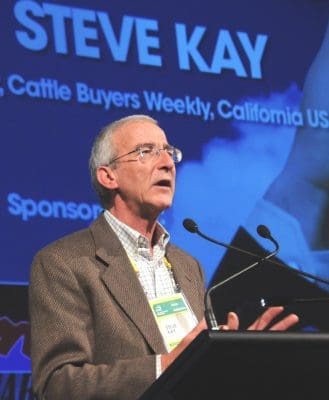 A monthly column written for Beef Central by US meat and livestock industry commentator, Steve Kay, publisher of US Cattle Buyers Weekly
A monthly column written for Beef Central by US meat and livestock industry commentator, Steve Kay, publisher of US Cattle Buyers Weekly
LIKE their colleagues in Australia, North American beef producers are well accustomed in dealing with good news/bad news scenarios.
The latest is that severe to extreme drought conditions have returned to much of the western half of the North American continent and are impacting everything from beef cow prices and liquidation to crop prices.
At the same time, consumers and wholesale beef demand in the US and around the globe are at 30-year highs, as the US and global economies recover. The strong demand has produced a level of optimism about US cattle prices that has been largely absent for the past 18 months.
Ranchers and grain farmers in western Canada are currently grappling both with the worst drought in years, and wildfires. This northern hemisphere fall (the next five to six months), is going to be dramatic with the number of cows, that are going to come to town, and the only place for them to go is to slaughter, Bob Balog with Balog Auction Services in Lethbridge Alberta in late August told MSN News.
The calls just keep coming from concerned producers spanning all the prairie provinces, he said. Most of the calls coming in have been about a lack of pasture. Now in the last ten days (of August), he is getting ‘lots and lots of calls’ because cattle producers are out of water. So it’s a double whammy. There is a third whammy with the fact there is very little if any hay, he said.
That in a nutshell sums up the challenges facing beef producers in Canada and much of the western US.
But the impact of drought on cull cow prices has been markedly different in the two countries. Canfax senior analyst Brian Perillat in late August said drought had driven the price of slaughter cows down US20c/lb and August is usually the strongest price month of the year.
It takes a good cow to make US80c/lb now, he said. Lots of cows are trading in the US70c range. In June, prices were over a dollar a pound. Some of the August cow prices were the lowest they have been in the month in almost ten years, he said.
Conversely, US cull cow prices remained above year-ago levels in August, although they had pulled back from summer peak prices. This was despite growing beef cow herd liquidation, which reflected the fact that 25pc of the nation’s cow herd is located within areas of varying degrees of drought.
But as the US cattle herd finds itself in its third year of liquidation, reduced calf crops will be price-positive for both feeder cattle and calves, says analyst Andrew Gottschalk, HedgersEdge.com.
The bigger impact is on crops and their prices. Drought and searing heat is severely impacting corn, wheat and soybean crops in many parts of the country. North and South Dakota, Minnesota, Iowa and Nebraska all contain areas of extreme drought, according to data from the US Drought Monitor. Prices in mid-August were much higher than a year ago. Omaha corn was US$6.32 per bushel versus US$2.97 a year ago and wheat was US$7.10 per bushel versus US$3.88 a year ago. That doesn’t augur well for feedlot costs of gains.
Meanwhile, the booming demand for beef and pork in US grocery stores meant retail prices in July set a new all-time high for pork and that Choice beef prices were close to their record set in May last year.
This July’s Choice beef price averaged US$7.53 per pound. This was up 6c from June and was 6c below the all-time monthly record of US$7.59 set in May 2020. It was 10.1pc higher than in July last year.
USDA’s All Fresh beef price averaged US$7.10 per pound, down a penny from June but up 5.3pc from a year ago. It set an all-time monthly record of US$7.38 per pound in June last year. August retail beef and pork prices likely set new records as retailers raised everyday prices and featured meat less to counter higher wholesale prices.
On the supply side, optimism is growing about the prospects for sharply higher grainfed cattle prices in the fourth quarter. The optimism reflects a declining front-end supply of cattle and lower steer and heifer carcase weights than last year. The number of cattle on feed 150 days or more on September 1 was expected to be up 6pc year-on-year. But it will be up only 1pc on October and down 10pc on January 1. This will equate to a 333,000-head decline in four months.
Carcase weights fell below year ago levels in May and will remain so in large part because of increased feeding costs.
The futures market currently reflects the optimism. The October live cattle contract closed last Tuesday week at US$125.90 per cwt and the December contract closed at US$133.47 per cwt.
USDA has raised its forecasts for third and fourth quarter fed steer prices US$4 per cwt to US$124 per cwt and US$127 per cwt, respectively. These prices seem conservative in light of the current level of futures prices.
The bottom line is that the renewed optimism about US cattle prices is most welcome after 18 months of pessimism. But what cattle producers most need is rain.



HAVE YOUR SAY